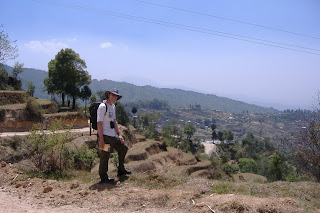Before moving onto a touchy subject, here are two more questions:
- Can you get a good cup of tea in Nepal? (Henry Massey Farwell – age 16 months and who loves tea).
Yes. In Kathmandu we can get a wide selection of teas, both in restaurants and in the tea-shops, which have loads of tins of tea-leaf varieties. The traditional Nepali tea (at least in these parts) is ‘Chiya’ which is similar to Indian ‘Chai’. It is weak, milky, sweet and with extra spices such as cardamon and cinnamon. Steve loves this but Mel prefers ‘thato cargati’ – hot lemon.
- What did you do for your birthday Steve? (Sharon Massey – age confidential)
Despite the fact that my birthday is not until 24th April, I have already received and devoured the parcel of home made sweets sent from home and had my main birthday treat. This was a long weekend in nearby villages where we stayed in friendly guest-houses, had nice walks and got great views of the Himalayas at dawn (yes-we did get up before sunrise to appreciate them). There are photos in the album but here’s a taster:

Now for ‘Kathmandu: A Touchy Subject’
A touch, that has been taking up much of our time and energy recently, has been choosing suitable fabrics for clothing. In particular, to help fit in with local culture, Mel has been buying some ‘kurtaa suruwaal’, which are local outfits. These come in a variety of bright colours and styles. We will post some photos of Mel in her outfits after they are back from the tailors. Sense of touch was valuable when it came to choosing a cool and comfortable fabric from the many on offer in the fabric shops. Here is a photo of one of the shops that Mel bought her fabric from:

Steve had a less enjoyable ‘touchy feely’ experience when he encountered a local hairy caterpillar. Although you may not think that a hairy caterpillar is as scary as a tiger, crocodile or cobra (all of which live in Nepal) they produce a very nasty rash and Steve wishes it to be known that he was very brave (if somewhat itchy):

Another common feeling is ‘rice between the fingers’. The custom here is to eat with your right hand. This can be fun, though tends to be messy for the inexperienced, especially with rice and ‘daal’ (which is mushy):

As dedicated ‘tree-huggers’ it has been nice to find new kinds of tree, such as this tangled Peepal Tree (a kind of fig), which are great to get our hands on:

Keep the questions coming and we’ll post again after we come back from our week-long village trip. Next time, ‘A taste of Nepal’.













